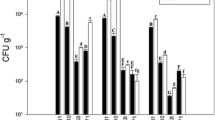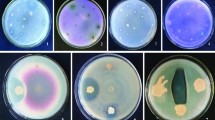Abstract
Siderophore production confers to bacteria competitive advantages to colonize plant tissues and to exclude other microorganisms from the same ecological niche. This work shows that the community of endophytic siderophore-producing bacteria (SPB) associated to Oryza sativa cultivated in Uruguayan soils is dynamic and diverse. These bacteria were present in grains, roots, and leaves, and their density fluctuated between log10 3.44 and log10 5.52 cfu g−1 fresh weight (fw) during the plant growth. Less than 10% of the heterotrophic bacteria produced siderophores in roots and leaves of young plants, but most of the heterotrophic bacteria were siderophore-producers in mature plants. According to their amplified restriction DNA ribosomal analysis (ARDRA) pattern, 54 of the 109 endophytic SPB isolated from different plant tissues or growth stages from replicate plots, were unique. Bacteria belonging to the genera Sphingomonas, Pseudomonas, Burkholderia, and Enterobacter alternated during plant growth, but the genus Pantoea was predominant in roots at tillering and in leaves at subsequent stages. Pantoea ananatis was the SPB permanently associated to any of the plant tissues, but the genetic diversity within this species—revealed by BOX-PCR fingerprinting- showed that different strains were randomly distributed along time and plant tissue, suggesting that a common trait of the species P. ananatis determined the interaction with the rice plant. Several isolates were stronger IAA producers than Azospirillum brasilense or Herbaspirillum seropedicae. In vitro inhibition assays showed that SPB of the genus Burkholderia were good antagonists of pathogenic fungi and that only one SPB isolate of the genus Pseudomonas was able to inhibit A. brasilense and H. seropedicae. These results denoted that SPB were selected into the rice plant. P. ananatis was the permanent and dominant associated species which was unable to inhibit two of the relevant plant growth-promoting bacteria.

Similar content being viewed by others
References
Alvindia D, Natsuaki T (2009) Biocontrol activities of Bacillus amyloliquefaciens DGA14 isolated from banana fruit surface against banana crown rot-causing pathogens. Crop Prot 28:236–242
Araujo W-L, Maccheroni W, Aguilar-Vildoso C-I, Barroso P, Saridakis H, Azevedo J (2001) Variability and interactions between endophytic bacteria and fungi isolated from leaf tissues of citrus rootstocks. Can J Microbiol 47:229–236
Asis C Jr, Adachi K (2004) Isolation of endophytic diazotroph Pantoea agglomerans and nondiazotroph Enterobacter asburiae from sweetpotato stem in Japan. Lett Appl Microbiol 38:19–23
Assigbetse K, Gueye M, Thioulouse J, Duponnois R (2005) Soil bacterial diversity responses to root colonization by an ectomycorrhizal fungus are not root-growth-dependent. Microb Ecol 50:350–359
Bacilio-Jimenez M, Aguilar-Flores S, del Valle M, Perez A, Zepeda A, Zenteno E (2001) Endophytic bacteria in rice seeds inhibit early colonization of roots by Azospirillum brasilense. Soil Biol Biochem 33:167–172
Baldani V, Döbereiner J (1980) Host-plant specify in the infection of cereals with Azospirillum spp. Soil Biol Biochem 12(4):433–439
Barraquio WL, Revilla L, Ladha JK (1997) Isolation of endophytic diazotrophic bacteria from wetland rice. Plant Soil 194:15–24
Berg G, Krechel A, Ditz M, Sikora R, Ulrich A, Hallmann J (2005) Endophytic and ectophytic potato-associated bacterial communities differ in structure and antagonistic function against plant pathogenic fungi. FEMS Microbiol Ecol 51:215–229
Cho K, Young Hong S, Mi Lee S, Hee Kim Y, Gjung Kahng G, Pyo Lim P, Kim H, Dae Yun H (2007) Endophytic bacterial communities in ginseng and their antifungal activity against pathogens. Microb Ecol 54:341–351
Compant S, Duffy B, Nowak J, Clément C, Ait Barka E (2005) Use of plant growth-promoting bacteria for biocontrol of plant diseases: principles, mechanisms of action, and future prospects. Appl Environ Microb 71(9):4951–4959
Conn V, Franco C (2004) Analysis of the endophytic actinobacterial population in the roots of wheat (Triticum aestivum L.) by terminal restriction fragment length polymorphism and sequencing of 16S rRNA clones. Appl Environm Microbiol 70(3):1787–1794
Doberman A, Fairhurst T (2000) Rice: nutrient disorders and nutrient management. International Rice Research Institute (IRRI), Singapore, MY
Elbeltagy A, Nishioka K, Sato T, Suzuki H, Ye B, Hamada T, Isawa T, Mitsui H, Minamisawa K (2001) Endophytic colonization and in planta nitrogen fixation by a Herbaspirillum sp. isolated from wild rice species. Appl Environ Microbiol 67:5285–5293
Engelhard M, Hurek T, Reinhol-Hurek B (2000) Preferential occurrence of diazotrophic endophytes, Azoarcus spp., in wild rice species and land races of Oryza sativa in comparison with modern races. Environ Microbiol 2:131–141
Enya J, Shinohara H, Yoshida S, Tsukiboshi T, Negishi T, Suyama K, Tsushima S (2007) Culturable leaf-associated bacteria on tomato plants and their potential as biological control agents. Microb Ecol 53:524–536
Felici C, Vettori L, Giraldi L, Costantina L, Toffanin A, Tagliasacchi A, Nuti M (2008) Single and co-inoculation of Bacillus subtilis and Azospirillum brasilense on Lycopersicon esculentum: Effects on plant growth and rhizosphere microbial community. Appl Soil Ecol 40(2):260–270
Feng Y, Shen D, Dong X, Song W (2003) In vitro symplasmata formation in the rice diazotrophic endophyte Pantoea agglomerans YS19. Plant Soil 255:435–444
Glickmann E, Dessaux Y (1994) A critical examination of the specificity of the Salkowski reagent for indolic compounds produced by phytopatogenic bacteria. Appl Environ Microbiol 61(2):793–796
Gyaneshwar P, James EK, Mathan N, Reddy PM, Reinhold-Hurek B, Ladha JK (2001) Endophytic colonization of rice by a diazotrophic strain of Serratia marcescens. J Bacteriol 183:2634–45
Iversen C, Lehner A, Mullane N, Bidlas E, Cleenwerck I, Marugg J, Fanning S, Stephan R, Joosten H (2007) The taxonomy of Enterobacter sakazakii: proposal of a new genus Cronobacter gen. nov. and descriptions of Cronobacter sakazakii comb. nov. Cronobacter sakazakii subsp. sakazakii, comb. nov., Cronobacter sakazakii subsp. malonaticus subsp. nov., Cronobacter turicensis sp. nov., Cronobacter muytjensiisp. nov., Cronobacter dublinensis sp. nov. and Cronobactergenomospecies. BMC Evol Biol 7:64
Kaga H, Mano H, Tanaka F, Watanabe A, Kaneko S, Morisaki H (2009) Rice seeds as sources of endophytic bacteria. Microb Environm 24(2):154–162
Kuklinsky-Sobral J, Araujo WL, Mendes R, Geraldi IO, Pizzirani-Kleiner AA, Azevedo JL (2004) Isolation and characterization of soybean-associated bacteria and their potential for plant growth promotion. Environ Microbiol 12:1244–1251
Li C-H, Zhao M-W, Tang C-M, Li S-P (2009) Population dynamics and identification of endophytic bacteria antagonistic toward plant-pathogenic fungi in cotton root. Microb Ecol 59(2):344–356
Loiret FG, Ortega E, Kleiner D, Ortega-Rodés P, Rodés R, Dong Z (2004) A putative new endophytic nitrogen-fixing bacterium Pantoea sp. from sugarcane. J Appl Microbiol 97:504–511
Mahaffee W, Kloepper J (1997) Temporal changes in the bacterial communities of soil, rhizosphere, and endorhiza associated with field-grown cucumber (Cucumis sativus L.). Microb Ecol 34(3):2210–223
Malik K, Bilal R, Mehnaz S, Rasul G, Mirza M, Ali S (1997) Association of nitrogen-fixing, plant-growth-promoting rhizobacteria (PGPR) with Kallar grass and rice. Plant Soil 194(1):37–44
Mano H, Tanaca F, Nakamura C, Kaga H, Morisaki H (2007) Culturable endophytic bacterial flora on the maturing leaves and roots of rice plants (Oryza sativa) cultivated in a paddy field. Microb Environm 22(2):175–185
Mc Inroy A, Kloepper J (1995) Survey of indigenous bacterial endophytes from cotton and sweet corn. Plant Soil 173(2):337–342
Miethke M, Marahiel M (2007) Siderophore-based iron acquisition and pathogen control. Microbiol Mol Biol 71(3):413–451
Mocali S, Bertelli E, Di Cello F, Mengoni A, Sfalanga A, Viliani F, Caciotti A, Tegli S, Surico G, Fani R (2003) Fluctuation of bacteria isolated from elm tissues during different seasons and from different plant organs. Microbiol Res 154(2):105–114
Naik S, Shashikala J, Krishnamurthy Y (2009) Study on the diversity of endophytic communities from rice (Oryza sativa L.) and their antagonistic activities in vitro. Microbiol Res 164(3):290–296
Okunishi S, Sako K, Mano H, Imamura A, Morisaki H (2005) Bacterial Flora of Endophytes in the Maturing Seed of Cultivated Rice (Oryza sativa). Microb Environm 20(3):168–177
Posada F, Vega F (2005) Establishment of the fungal entomopathogen Beauveria bassiana (Ascomycota: Hypocreales) as an endophyte in cocoa seedlings (Theobroma cacao). Mycologia 97(6):1195–1200
Prakamhang J, Minamisawa K, Teamtaisong K, Boonkerd N, Teaumroong N (2009) The communities of endophytic diazotrophic bacteria in cultivated rice (Oryza sativa L.). Appl Soil Ecol 142(2):141–149
Reiter B, Pfeifer U, Schwab H, Sessitsch A (2002) Response of endophytic bacterial communities in potato plants to infection with Erwinia carotovora subsp. atroseptica. Appl Envrion Microbiol 68:2261–2268
Rosenblueth M, Martínez Romero E (2006) Bacterial endophytes and their interactions with hosts. Mol Plant Microb Interact 19(8):827–837
Ryan P, Germaine K, Franks A, Ryan D, Dowling D (2008) Bacterial endophytes: recent developments and applications. FEMS Microbiol Lett 278(1):1–9
Schulz B, Boyle C (2006) What are endophytes? In: Schulz B, Boyle C, Sieber T (eds) Microbial root endophytes. Springer-Verlag, Berlin, pp 1–13
Schwyn B, Neilands JB (1987) Universal chemical assay for the detection and determination of siderophores. Anal Biochem 160:47–56
Steibl HD, Siddavattam D, Klingmuller W (1995) Self-transmissible nif plasmid (pEA9) of Enterobacter agglomerans 339: molecular cloning and evidence for the existence of similar nif clusters on dissimilar plasmids in Enterobacter strains. Plasmid 34:223–8
Stoltzfus J, So R, Malarvithi P, Ladha J, de Bruijn F (1997) Isolation of endophytic bacteria from rice and assessment of theri potential for supplying rice with biologically fixed nitrogen. Plant Soil 194:25–36
Sturz AV, Christie BR, Matheson BG, Nowak J (1997) Biodiversity of endophytic bacteria which colonize red clover nodules, roots, stems and foliage and their influence on host growth. Biol Biofertility Soils 25:13–19
Sun L, Qiu F, Zhang X, Dai X, Dong X, Song W (2008) Endophytic bacterial diversity in rice (Oryza sativa L.) roots estimated by 16S rDNA sequence analysis. Microb Ecol 55(3):415–424
Verma S, Ladha J, Tripathi A (2001) Evaluation of plant growth promoting and ability of endophytic diazotrophs from deep water rice. J Biotechnol 91:127–141
Yang J-H, Liu H-X, Zhu G-M, Pan Y-L, Guo J-H (2008) Diversity analysis of antagonists from rice-associated bacteria and their application in biocontrol of rice diseases. J Appl Microbiol 104:91–104
Yasmin S, Bakar M, Malik K, Hafeez F (2004) Isolation, characterization and beneficial effects of rice associated plant growth promoting bacteria from Zanzibar soils. J Basic Microbiol 44(3):241–252
Acknowledgments
We are grateful to Dra. Silvana Vero for technical suggestions and critical reading of the manuscript. We acknowledge Dra. Silvana Tarlera for her assistance to edit this manuscript. We also thank Stella Ávila for providing the pathogenic fungi and José Terra for allowing us to take samples from his field assay, both of them are researchers of the Instituto Nacional de Investigaciones Agropecuarias, Uruguay. This work was supported by CSIC (Comisión Sectorial de Investigación Científica, Universidad de la República, Uruguay), Projects 345 I + D, and 440 SP, and by ANII (Agencia Nacional de Investigación e Innovación) providing a scholarship for I. Loaces.
Author information
Authors and Affiliations
Corresponding author
Rights and permissions
About this article
Cite this article
Loaces, I., Ferrando, L. & Fernández Scavino, A. Dynamics, Diversity and Function of Endophytic Siderophore-Producing Bacteria in Rice. Microb Ecol 61, 606–618 (2011). https://doi.org/10.1007/s00248-010-9780-9
Received:
Accepted:
Published:
Issue Date:
DOI: https://doi.org/10.1007/s00248-010-9780-9




